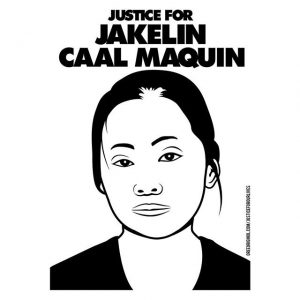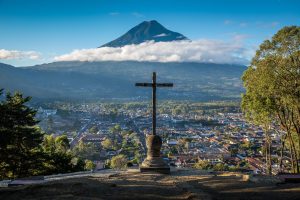On the night of November 30th, 2018, Jakelin Amei Rosmery Caal Maquin’s began her path towards death. After a tough journey that lasted seven days, on Thursday December 6ht, the girl, her father and hundreds of other people entered US soil and turned themselves in to the authorities. Two days after, on Saturday December 8th, members of the Border Patrol informed the father that his little girl had died. Two weeks later, on the night of December 24th, another similar tragedy occurred: Felipe Gómez, 8 years old, died after crossing the border. The two children had fled from Guatemala. They had embarked on a three-kilometer journey in conditions of hunger, hardship, and extreme cold. Both died in situations that legitimize asking about the healthcare treatment they received, and for the dehumanized immigration policy that Donald Trump has put in place, with the support of the Republican Party.

Similar to many other Guatemalans, Jakelin and Felipe escaped from the inclement poverty in which the Mayan villages live, where there is no education, no medical services, or investments of any kind. Academics and members of NGOs have warned that racism is still alive in Guatemala, and that the Maya, who make up no less than 40% of the population, survive under a “de facto apartheid.” It has been denounced that the objective behind expelling them from their lands is to dedicate them to the production of palm oil. The combination of abandonment and violence could, within a very short period of time, achieve this result, at a very high expense of Mayan’s lives.
An overview of Guatemala
Guatemala has the largest population in Central America. Over 17 million people reside in its territory of almost 110 thousand squared kilometers (42,471 sq. miles). Several estimates maintain that half of the population lives in extreme poverty conditions, despite the fact that, for about four decades, the country has presented figures of sustained growth. The widespread and chronic malnutrition, the high rate of maternal and infant mortality, and the levels of consumption below the minimum needs suggest that the economy continues to be deficient with respect to the needs of Guatemalans. Moreover, it suggests that the redistribution of growth has a negative behavior: it only benefits a very small number of people.

In fact, since the 1980s, Guatemala has been growing at an average of 3% per year. In 2015, the trend experienced a peak and reached 4.1%. Since then, it has begun to decline gradually. Between 2007 and 2014, foreign investment went from 20.8 to 12.2 of its GDP. In 2018 the economy contracted by 2.8%, and many are wondering if what can be expected, from now on, is the end of a cycle that, although modest, has been positive. The drop in oil production in 2018—of 5% relative to that of 2017—is another of its citizens’ source for concern.
According to the Guatemalan Association for Research and Social Studies (ASIES), there are around 3 million Guatemalans living in the United States—most of them illegally. In recent years, the importance of remittances has grown considerably. In 2010, they totaled 4.1 billion dollars. The estimate for 2018 has doubled: around 8.5 billion dollars, which is equivalent to almost 11% of the GDP. It is fundamental to note that remittances are the second source of income in the country. The impotence of the economy is evident in these two figures: every year 200 thousand young people enter the labor market, but job offers do not exceed 25 thousand positions. Surveys indicate that 75% of young people want to emigrate.
Civil War Aftermath
Like many readers will remember, Guatemala suffered a civil war between 1960 and 1996. During this time, between 250 and 300 thousand people either lost their lives or disappeared. In addition, more than 100 thousand were displaced, and thousands of hectares were razed. After the signing of the peace accord, the country was strewn with arms. Part of these weapons became one of the facilitators of the violence that is now decimating Guatemalan society.
On May 14th, 2018, many newspapers around the world celebrated what was adopted as novel news: the day before there was not a single murder in Guatemala City, one of the most dangerous cities in the world. While the country calculates a average of 26 deaths per 100 thousand inhabitants—non-governmental entities claim that the average is 32—, in the capital the rate rises to 75. It increases almost three times! This violence generates a cost higher than 8% of GDP.
With an extended and hopeless poverty backdrop, a series of events have aggravated the situation: an illegal, easy-access market for weapons; police groups with abundant members who are partners or accomplices of criminals; an increasingly fragile, politicized, and bureaucratic judicial system; and tens of thousands of young people, hopeless about their future, joining gangs, especially in Guatemala City.
A document from the Center for National Economic Research (CIEN) indicated, in February 2018, that some 15,000 people—mostly young people—are part of gangs. Only 10% of them are in prison. The report called attention to a surprising fact: there are no official statistics on this serious and urgent problem. A series of factors—“marginalized young men, disorderly urban growth, dysfunctional families that perpetuate the cycles of violence, unemployment, relative poverty, scarce legitimacy of the State, police and judicial inefficiency, drug-alcohol abuse, carrying weapons, legitimizing the use of violence”—concur to promote crimes and violent actions. In 2015, the Guatemalan newspaper La Hora affirmed that the number of young gang members exceeded 19,000. Most sources agree that the Guatemalan State has not been able to establish efficient preventive policies.
The Challenges at Hand
Reports by NGOs, associations, analysts of different specialties, social leaders, and the media on the state of the Guatemalan institutions are not limited to the judicial system. According to them, there is an exacerbated bureaucracy in the vast majority of the offices; procedures that encourage corruption; entities subject to the pernicious influence of politics; and budgets that are very, very far from being able to provide basic coverage to the needs of the population. It is no exaggeration to state that the worst of politics, its most opaque ways, have spread almost uncontrollably. The murder of 6 journalists in 2018, and the constant practice of threatening the media and information professionals, is revealing of the deep connections that exist between corruption and violence. Guatemala is one of the countries of the continent where exercising the obligation to inform can cost reporters their life, and where the links between politicians and businessmen can be a source of enormous distortions.
None of the challenges Guatemala is facing is small. Its investment in health, less than 3% of GDP; the quality of their educational system, whose results are simply alarming; the state of its road; the climate change risks that the country faces; the lack of effective incentives that make private sector investment possible; all are, to a large extent, the aftermath of a country overwhelmed by confrontations and the voracity of politics.
Fight against corruption
On January 14th, 2016, Jimmy Morales Cabrera assumed the presidency of Guatemala. The corruption allegations made by the International Commission against Impunity in Guatemala (CICIG)—created in 2006 as a result of an agreement between the UN and the government of the time—favored the rise of Morales to power. In 2017 the tensions between Morales and CICIG appeared. During 2018, these were made open and began to be confronted publically. The trigger was the investigation started by the entity, regarding the illegal financing of Morales’ election campaign, which points him to him, his brother, and a son.

To prevent the investigation from reaching the end, Morales began a political, legal, and communicational war that crossed this extreme: he confronted the CICIG in the Supreme Court of Justice, which issued measures to safeguard the legality and activity of CICIG. There were street demonstrations in favor of CICIG and its head, the public prosecutor Iván Velázquez Gómez. Guatemalan public opinion polarized around this case. António Guterres, Secretary General of the UN, issued a statement ratifying the support of the multilateral entity to the investigating group. Morales ignored the measures of the Supreme Court of Justice and, on January 7, unilaterally broke the agreement with the UN and canceled the operation of CICIG. The government accuses them of having exceeded their functions, politicizing their management, and constituting a danger to the country’s governability. For over a little more than a decade of activity, the CICIG carried out investigations that involved more than 600 people in corruption crimes.
The measure taken by President Morales probably does not close the chapter. Norma Torres, congresswoman of the Democratic Party of Guatemalan origin, has given clear statements on the matter: what is at stake is the rule of law. By going over the Supreme Court of Justice’s decision, Jimmy Morales has broken with a fundamental project that his country maintained with the UN, to protect himself and his family. The question that derives from all the above, does not refer only to the future of Morales, but also to the impact that the case will have in the immediate future of Guatemala.
A call to Secure Democracy for Guatemala
I have read analysts who maintain that the image the majority of Guatemalans have of Jimmy Morales has been altered. The next electoral process that will take place in June will verify whether the recognition that the surveys attribute to CICIG affects Morales, to the point of preventing him from being re-elected. There is a high probability that Morales will face the candidacy of the lawyer Thelma Aldana, who served as Attorney General and head of the Public Ministry until May 2018. Aldana, who enjoys notorious popularity as an anticorruption champion, appeared in 2017 as one of the most influential people in the world, according to Time magazine.
For some years, qualified voices have been repeating that Guatemala is on the way to becoming a failed State. In Guatemalan society, there are increasingly broad currents of opinion that harbor a distrust of institutions. The reality of the corruption, which has extended to the various branches of government, associations, courts, security forces, and the numerous branches of public administration, makes it difficult for the country to make the leap. Public policies do not reverse the difficulties, international aid is reduced by mistrust, investors do not dare, citizens survive in an environment that lacks guarantees, and the fight against corruption—I do not include the CICIG—is used by other corrupt beings to reach positions of power.
Guatemala needs to, fundamentally, break the paradigm of citizens and society versus institutions. The feeling that the economy only benefits a few, and that the rest is condemned to live hopelessly, can act like a ticking time bomb. As a result, exploding its democracy, unleashing even more bloody violence, feeding racism, and making coexistence even more difficult. Instead of breaking the pact with the UN and liquidating the CICIG, perhaps it would be convenient to renew the national pact against corruption, create a large investment program aimed at alleviating poverty, and establish codes to ensure that institutions comply with its purpose. If the country leaders evade these important tasks, Guatemala could be the protagonist of very bad news for democracy and freedom any day now.
